Abstract
This study applies the life cycle assessment methodology to evaluate the environmental impacts of shock-absorbing pavements fabricated with recycled materials (crumb rubber and a colored pigment called ferrotone), employing the “cradle-to-grave” approach, in which the impacts of all life cycle phases (from materials’ acquisition to the end-of-life of the pavement) are included. The analysis compares the impacts of standard and innovative asphalt materials, considering cold and hot production processes. In addition, three different lifespans are simulated for the pavement structures: the reference service life until the first intervention is considered to be 5 years, and the following scenarios consider that the alternative asphalt materials may last 20% less (4 years) or 20% longer (6 years) than the reference service life. The analysis uses non-renewable cumulative energy demand (nr-CED) and global warming potential (GWP) as main indicators to determine the environmental impacts over a 45-year analysis period. The results show that adopting the “dry process” (consisting of adding the rubber as a partial substitution for aggregates) increases the overall impacts due to the need for higher contents of binder. However, if the alternative pavement structures last 20% longer than the reference, they would generate lower impacts in terms of nr-CED and GWP.
1. Introduction
Rubber from end-of-life tires (ELTs) has already been used for many years in pavement solutions and in the construction industry [1,2,3,4,5,6,7,8,9]. Nowadays, it is used particularly in asphalt applications to produce asphalt-rubber or rubberized asphalt to make pavements more durable and resilient. The same recycled rubber is also used in sport-related applications thanks to its elastic and absorbing characteristics [10,11,12]. A common feature of the rubberized asphalt material and sports floor/playground is the ability to incorporate ELT rubber, a resource-rich material, into its mix design/formulation. In this case, the main properties of the rubber used for these solutions are the elasticity and shock-absorbing performance needed to damp and spring the energy back to the individual and reduce the risk of traumas [10,12].
The potential of the material explains the increasing number of innovative projects applying ELTs into bituminous materials, exploiting rubber’s properties for more user-friendly and greener applications, such as noise-reducing or energy-saving solutions, as developed in previous studies [13,14,15].
The impact-absorbing pavements (IAPs) and their goal to reduce injuries for Vulnerable Road Users (VRUs) are located at the intersection of standard asphalt surfaces and playgrounds’ soft pavements. The concept was developed because a negligence of the risk of standard stiff surfaces to foster injuries was observed in the case of non-collision incidents or falls of VRUs—the users not protected by a shield—together with the necessity to manage an important amount of tyres at the end of their life. The IAPs’ material is in fact designed to accommodate the everyday mobility of users on sidewalks and bike lanes, while reducing the risks of injuries due to impacts caused by potential falls [16,17].
The aim of this solution is allowing the use of traditional methods of paving, from mixing to laying, without disruptions and altered working approaches, even for large paving surfaces. The reduction of externalities is also targeted by means of cold- or hot-mix asphalt binders, to reduce the CO2 emissions and hazardousness for the environment, the workers and the population.
Initial versions of hot-mixed IAPs are described in the studies by Wallqvist and Kraft et al. [16,18,19] and were developed in Sweden. The results were encouraging; however, a considerable amount of rubber was reported to cause several production issues, i.e., the reduction of the workability, the increase of smell and fumes, as well as the overconsumption of asphalt binder during the process.
Moreover, previous studies from the authors introduced the cold binder and demonstrated the feasibility of cold-mixed IAP, allowing the increase of workability, the diminution of externalities and the save in production energy (from 140–160 °C to ambient temperature) [17,20]. As the rubber holds a central role in the IAP formulation, further analysis and data collection is needed, related to the durability over time and weathering of the material and the potential impact on the environment [17,20].
The Life Cycle Assessment (ISO 14040) is the most-used methodology to evaluate the environmental impacts of alternative asphalt mixtures, and it might show paradoxical results depending on the chosen indicators. For instance, Khater et al. [21] assessed the environmental impacts of using lignin and glass fiber to improve the quality of road pavements and minimize moisture damage and cracking at low temperatures on asphalt pavement. The authors concluded, for example, that lignin-modified asphalt mixture has the highest negative effect in marine aquatic ecotoxicity potential and freshwater aquatic ecotoxicity potential categories but has the best environmental impacts on most other impact categories. This suggests that indicators must be carefully defined considering the main objectives of the study.
This study assesses the environmental potentials of using crumb-rubber and ferrotone pigments—used to color the bulk of the pavement coating as an alternative to additional paint layers that often increase slipping incidents—to build impact-absorbing pavements through the use of the Life Cycle Assessment (LCA) methodology, considering two main indicators: Global Warming Potential (GWP) and Non-Renewable Cumulative Energy Demand (nr-CED). In order to investigate the influence of mixing temperatures, both hot and cold production procedures are considered in the analysis.
2. Materials and Methods
This study assesses the environmental impacts of asphalt materials composed with crumb rubber (from 0 to 4 mm), tested in a laboratory with cold-and hot-mix production. In order to compare the performance of the asphalt mixtures, reference samples made only with aggregates and binder are included in the analysis. Additionally, the influence of using ferrotone (pigment)—which allows us to color the matrix and might be beneficial for further urban road planning and improving the visibility of vulnerable road users—is investigated.
All the samples were produced using the “dry process”, which consists of adding the rubber as a partial substitution for aggregates using 0–4 mm size fraction of crumb rubber. Indeed, in the case of the dry process, the incorporation of high quantities of crumb rubber is facilitated without the need to mix the rubber with the binder prior to the mix with the aggregates, often at high temperatures and for a longer time, as is recommended with the wet process.
The reference gradation curve corresponds to the hot-rolled asphalt, known to contain a consequent amount of fine. The characteristic was preferred because of the willingness to include a high amount of crumb rubber. The composition and density of each mix are shown in Table 1.

Table 1.
Asphalt mixtures composition.
WCR and CCR are relatively similar, having variations only within the binder type (bitumen for hot production and emulsion for cold mixtures). Moreover, two reference mixtures, CREF and WREF, were also studied as basis of comparison.
As for the compaction, two types of binders from the same supplier were used:
- -
- Styrene–Butadiene–Styrene Polymer-modified bitumen (SBS-PmB)
- -
- Styrene–Butadiene–Styrene Polymer-modified emulsion (SBS-PmE)
The binders’ properties are given in Table 2:

Table 2.
Bitumen and emulsion properties.
After the production, all the samples were characterized in the laboratory with volumetric [22,23,24], mechanical [25,26,27], impact-attenuation [28,29], leaching [30], and natural ageing, and the values are shown in Makoundou et al. [17,20] and Fathollahi et al. [30]. The samples CCR, CRED and WCR also underwent freeze-thaw cycles analysis [17,31].
The results of the testing allowed for the development of a field trial using the optimized version of the CCR mixture [20].
3. Life Cycle Assessment
3.1. Goal
This study was conducted to assess the environmental potentials of using crumb rubber from tires to build impact-absorbing pavements in order to reduce pedestrian injuries.
3.2. Scope of the Study
3.2.1. System Boundaries
The “cradle-to-grave” approach is employed in this study. Therefore, all life cycle phases, from raw material acquisition (A1) to the end-of-life of the pavement (C4), are considered in the analysis.
The reference mixtures (i.e., CREF and WREF) are entirely fabricated with primary raw materials (aggregates, bitumen and emulsion), while the alternative mixtures (i.e., CCR, CRED and WCR) also contain crumb rubber, ferrotone and cement (Table 1). Both primary and secondary raw materials are acquired from different suppliers located across Europe and transported to the asphalt plant (hot mix) or directly to the construction site (cold mix) to proceed with the manufacturing of asphalt mixtures.
The crumb rubber is a secondary raw material originated from the milling of tires, therefore, all environmental burdens related to the life cycle of tires are excluded from the system boundaries, except for the trituration process (Figure 1).
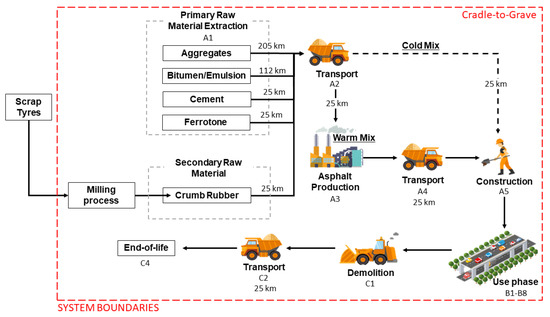
Figure 1.
System boundaries of the study.
The terminology used to describe the life cycle stages in Figure 1 is defined in the EN 15804:2018 standard [32], as presented below:
- A1: raw material supply;
- A2: transport of raw material to the manufacturer;
- A3: manufacture of the asphalt mixtures at the asphalt plant;
- A4: transport of asphalt mixtures to the construction site;
- A5: construction of pavements;
- B1–B8: use, maintenance, repair, and replacement of asphalt layers;
- C1: demolition of pavement;
- C2: transport of milled asphalt pavement to the disposal site;
- C4: final disposal of end-of-life product.
The asphalt mixtures produced in the asphalt plant at temperatures that reach 160 °C are transported to the construction site to build the pavements, whereas the cold mixtures are blended “in situ” in ambient temperature, using emulsion as binder. The addition of crumb rubber follows the dry process, partially substituting the fraction of aggregates originally applied.
The analysis considers that the asphalt mixtures are placed in the top layer (5 cm) of sidewalk pavements with an unbound layer made with mineral aggregates as sub-base (45 cm). In terms of maintenance strategy, three different scenarios are adopted: (1) the first scenario considers that all pavements would have 5 years of lifetime for the top layer and 15 years for the unbound layer; (2) the second scenario considers that the alternative asphalt mixtures would last 20% less (4 years) than the reference asphalt mixtures; and (3) the third scenario considers that the alternative asphalt mixture would last 20% longer (6 years) than the references. The analysis period used in this study is 45 years. Table 3 shows the evaluated scenarios:

Table 3.
Maintenance strategy applied to the pavements.
3.2.2. Functional Unit
The environmental impacts of the production process of asphalt mixtures is shown in kilograms of asphalt mixture produced at the asphalt plant, while the functional unit used to evaluate the lifetime of a road pavement over a 45-year analysis period is in square meters (m2) of pavement.
3.3. Life Cycle Inventory (LCI)
The primary data associated with the production of asphalt mixtures were taken from various sources. The recipes were designed in the laboratory by the authors. Therefore, only the asphalt mixtures that obtained satisfactory performance are included in this analysis. The asphalt materials were also tested for leaching, and the results were included in the category “emissions to soil” during the modeling process.
Information related to raw material suppliers and amounts of electricity and water consumption were taken from Siverio Lima et al. [33,34]. The distances to transport either the primary (205 km for aggregates, 112 km for bitumen/emulsion, and 25 km for cement and ferrotone) or secondary raw material (25 km for crumb rubber) were calculated considering the asphalt plant (hot mix) and the construction site (cold mix) as the final destination. The materials are transported from the origin to the asphalt plant by a five-axle lorry vehicle (EURO 6) [35], that weighs around 14 tons and has a maximum load capacity of 26 tons. The fuel consumption varies from 0.18 L of biodiesel per kilometer when empty to 0.32 L of fuel per kilometer when fully loaded.
The energy required to produce hot asphalt mixtures was calculated using Equation (1) [36,37]. Hence, inputs such as the specific heat coefficient of materials and latent heat of vaporization of water of Equation (1) [36,37] were obtained from Santos et al. [37]. The variables used in the aforementioned formula are available in Table 1 and Table 4.

Table 4.
Variables used to calculate the energy demand.
The crumb-rubber dataset was sourced by Farina et al. (2017) [38], which assumes that the production of 1 ton of crumb rubber demands 384 kWh of electric power and 2.99 L of diesel oil. Additional relevant input and output data regarding the production, construction and deconstruction processes (such as the machines used) were obtained from the literature [9,17,39]. The construction process of the asphaltic layer includes spraying the bitumen emulsion, paving, rolling and compacting processes, whereas the construction process of the sub-base includes distribution of mineral aggregates and rolling. The deconstruction process comprises milling (asphalt layer) and loading the unbound layer with a hydraulic digger.
The mineral aggregates were modeled using the dataset for “crushed gravel”. The hot asphalt mixtures were modeled using the same dataset for bitumen, whereas the emulsion used to produce cold asphalt mixtures was modeled containing 70% of bitumen. The ferrotone was modeled using the dataset for “Portafer”, which is a micaceous iron oxide (Fe2O3) used as mineral pigment.
All the inputs and outputs were modeled using SimaPro 9.3 (PRé Sustainability: Amersfoort, The Netherlands) [40] and the Ecoinvent 3.5 database (Ecoinvent: Zurich, The Switzerland) [41]. All the dataset used to perform the analysis and results are shown in the Supplementary Material.
3.4. Life Cycle Impact Assessment
To assess the environmental impact of road pavements, we adopted the GWP (kg CO2 equivalent) indicator used in the Environmental Product Declarations (EPD 2018) [42] method and the non-renewable cumulative energy demand (nr-CED) parameters, which are based on the Cumulative Energy Demand method V1.11 in Ecoinvent version 2.0 [41] and presented in MJ equivalent.
4. Results and Discussion
4.1. Asphalt Materials
Figure 2 shows the environmental impacts in terms of nr-CED and GWP to produce 1 kg of asphalt mixtures. As demonstrated, the asphalt mixtures produced with crumb rubber potentially generate more impacts (nr-CED and GWP) than the reference mixtures.
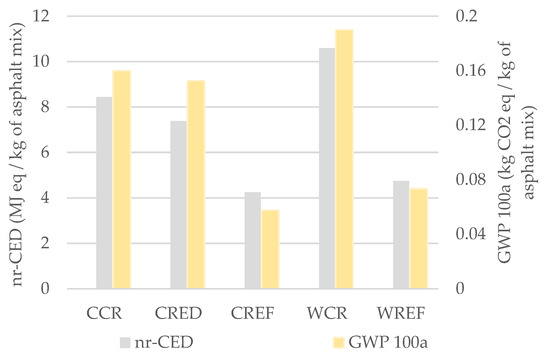
Figure 2.
Environmental impacts to produce 1 kg of asphalt mixtures.
As shown in Figure 2, the cold asphalt mixture produced with crumb rubber (CCR) demands 98% more energy than the reference (CREF) and 14% more than the mixture with ferrotone (CRED). In terms of hot mix, the reference (WREF) demands 123% less energy than the hot mixture made with crumb rubber. While comparing cold versus hot production (CCR vs. WCR and CREF vs. WREF), the cold procedure can save 10–20% of the energy demand and up to 21% of the greenhouse-gas emissions (GHG). The production of reference mixtures releases between 36 and 39% of CO2 of the amount emitted by the production of mixtures with crumb rubber and ferrotone.
In this study, the dry process was used to incorporate crumb rubber into the asphalt mixtures. Thus, the alternative material substitutes part of the aggregates, which demands higher contents of binder.
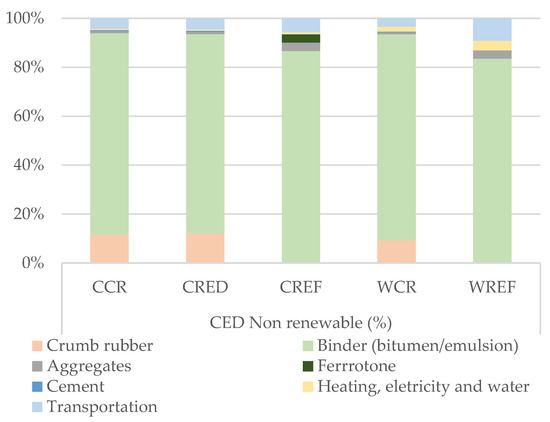
Figure 3.
Percentage of impact in terms of nr-CED for each category.
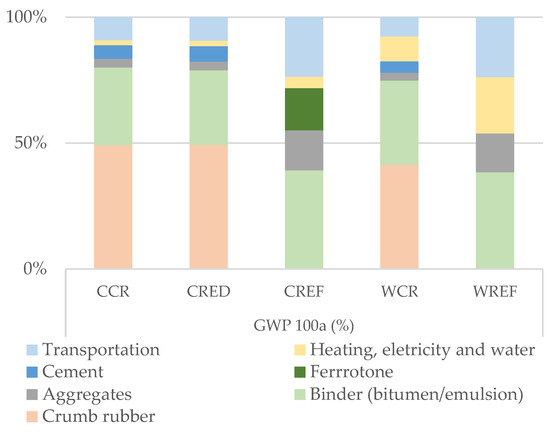
Figure 4.
Percentage of impact in terms of GWP for each category.
As shown in Figure 3 and Figure 4, the bitumen/emulsion plays an important role within the overall results, being responsible for up to 87% of the energy demanded and up to 39% of the CO2 emissions generated during the asphalt mixture’s production. In addition, the crumb rubber is responsible for 41–49% of the overall GHG emitted during the process due to the amount of electricity demanded to transform scrap tires into crumbs (Figure 5) and because the energy is sourced from fossil fuels, which consequently produces large quantities of carbon dioxide when burned.
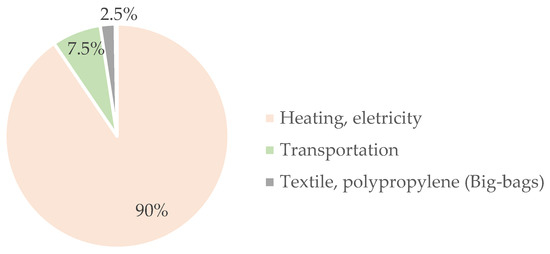
Figure 5.
GWP impact of crumb rubber input categories.
Even though the cold asphalt mixtures are made with emulsion—which represents 70% of the impacts caused by the bitumen—the higher contents of binder used and the impact caused by the milling process of tires provoked the highest impacts produced by the alternative asphalt mixtures (i.e., CCR, CRED and WCR).
The transportation has a major influence in reference asphalt mixtures (CREF and WREF) since it uses raw materials (aggregates) that require higher transportation distances.
4.2. Pavement Structures
Figure 6 and Figure 7 present the environmental impacts of pedestrian pavement structures build with the asphalt materials previously introduced. The study considers three different scenarios of a pavement lifetime, with 45 years as the period of analysis.
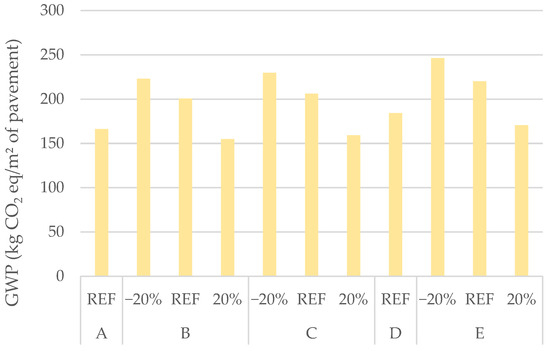
Figure 6.
GWP of pavement structures in three lifespan scenarios: 4 years (−20%), 5 years (REF) and 6 years (+20%) over a 45-year analysis period.
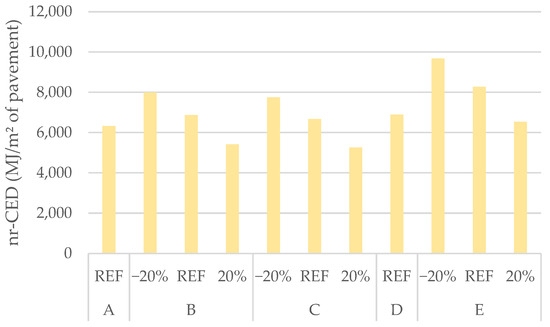
Figure 7.
nr-CED of pavement structures in three lifespan scenarios: 4 years (−20%), 5 years (REF) and 6 years (+20%) over a 45-year analysis period.
Typically, the environmental impact (nr-CED and GWP) increases when the lifetime of the pavements is reduced by 20% due to the demand for more interventions. The opposite happens when the pavements last longer (+20%).
If in a hypothetical scenario all asphalt pavements last exactly the same time (REF), building pavements with reference cold asphalt mixtures (CREF) would be the “most environmentally friendly” option in terms of both indicators, and the least-recommended would be using the hot mixture with crumb rubber. This indicates that using the cold production method reduces the environmental impacts over time. Considering all three scenarios, the highest impact values are shown by pavements built with WCR with reduced lifespan. The least impact is produced by pavements with a longer lifetime (+20%), constructed with asphalt mixtures CCR (GWP) and CRED (nr-CED).
As shown in Figure 6 and Figure 7, asphalt mixtures with crumb rubber and with ferrotone have lower environmental impacts in terms of energy demand and CO2eq emissions when they last 20% longer (i.e., around 6 years) than the reference asphalt mixtures.
After 45 years, applying CCR and CRED (+20%) instead CREF could reduce the impact by 4–7% for GWP and 14–17% in terms of energy demand. Using WCR (+20%) instead of WREF reduces the GWP by 7% and the CED by 5%.
5. Conclusions
This study evaluated the environmental impacts of using alternative asphalt materials (crumb rubber and a colored pigment called ferrotone) to build impact-absorbing pavements and compared them with reference asphalt mixtures usually produced with binder (bitumen/emulsion) and aggregates. The experimental asphalt mixtures are produced with two different techniques: cold and hot mixing procedures. Since it was not possible to determine the lifespan of the newly alternative asphalt materials developed, this analysis considers the environmental impacts of pavements applying three different lifespans: 4 (−20%), 5 (REF) and 6 years (+20%) over a 45-year period of analysis.
The results showed that asphalt mixtures fabricated with crumb rubber and ferrotone generate higher impacts than reference mixtures because of the dry process, in which the crumb rubber partially substitutes the aggregates, requiring higher contents of binder. In fact, the production of binders is itself a highly impactful process that demands a lot of energy and generates large quantities of GHG, representing a large share of the overall impact (nr-CED and GWP) results. In addition, the shredding process of tires to produce the crumb rubber uses a considerable amount of energy that comes from fossil fuels and automatically increases the emissions.
Considering only the production process of the asphalt mixtures, it is possible to observe that the environmental impacts of cold asphalt mixtures with crumb rubber generate 156 kg CO2 eq per ton of asphalt mixtures produced, while the hot process demands approximately 190 kg CO2 eq per ton of asphalt mixtures produced at the asphalt plant. According to the literature [34], a Stone Mastic Asphalt (SMA 8 S) used in road pavements generates around 67 kg CO2 eq/ton of asphalt mixtures produced. Depending on the layer applied and possible use of reclaimed asphalt materials (RAP), the emissions of materials such as an Asphalt Concrete (AC 32 TN + 60% RAP) in hot conditions can reach 41 kg CO2 eq/ton of asphalt mixtures produced. This means that producing asphalt materials to build impact-absorbing pavements generates almost four times more CO2 emissions than a regular asphalt mixture used in road pavements.
However, it is important to consider that technology is recently developed and there is a lack of literature available in terms of LCA analysis, making comparisons difficult. Furthermore, due to funding reasons and consortium agreements, the materials used to fabricate the IAPs were sourced from different countries, which increased the environmental impacts due to transportation distances (e.g., the crumb rubber was sourced from a company in Sweden and the production process happens in Italy). Therefore, future studies should consider distinct suppliers and verify the impact of the final results.
In this study, only one type of bitumen/emulsion (SBS PmB; SBS) and pigment were used; therefore, in order to obtain a wider range of results and to verify possible perspectives, a more extensive analysis using different raw materials options is required.
The analysis also shows that alternative asphalt mixtures (with crumb rubber) that last 20% longer than reference options potentially cause less impacts in terms of nr-CED and GWP over a 45-year analysis period. However, to obtain more accurate data and investigate the full sustainability potential of IAPs, future analysis should apply realistic lifespans and consider the social benefits that this material could provide to society, such as the "injury reduction" rate.
Supplementary Materials
The following supporting information can be downloaded at: https://www.mdpi.com/article/10.3390/su142214798/s1.
Author Contributions
All authors have contributed for the current paper. Data collection, writing—original draft preparation, M.S.S.L. and C.M.; supervision, project administration, funding acquisition, C.S. and F.G.; writing—review and editing, M.S.S.L., C.M., C.S. and F.G. All authors have read and agreed to the published version of the manuscript.
Funding
This project has received funding from the European Union’s Horizon 2020 research and innovation program under the Marie Sklodowska-Curie grant agreement No. 765057.
Institutional Review Board Statement
Not applicable.
Informed Consent Statement
Not applicable.
Data Availability Statement
Not applicable.
Acknowledgments
The authors appreciate the support given by the European Union by funding the SAFERUP! Project, an innovative training network devoted to develop safe, accessible, and urban pavements.
Conflicts of Interest
The authors declare no conflict of interest.
Abbreviations
| CCR | Cold mix—Crumb Rubber |
| CRED | Cold mix—with Ferrotone |
| CREF | Cold mix—Reference |
| ELTs | Rubber from end-of-life tires |
| EPD | Environmental Product Declarations |
| GHG | greenhouse-gas emissions |
| GWP | global warming potential |
| IAPs | Impact-absorbing pavements |
| LCA | Life Cycle Assessment |
| M1 | First maintenance intervention |
| M2 | Second maintenance intervention |
| M3 | Third maintenance intervention |
| Nr-CED | Non-renewable cumulative energy demand |
| RTFOT | Rolling thin film ovens |
| SBS-PmB | Styrene-Butadiene-Styrene Polymer-modified bitumen |
| SBS-PmE | Styrene-Butadiene-Styrene Polymer-modified emulsion |
| VRUs | Vulnerable Road Users |
| WCR | Hot mix—Crumb Rubber |
| WREF | Hot mix—Reference |
References
- Camille, A. Issa and George Salem. Utilization of recycled crumb rubber as fine aggregates in concrete mix design. Constr. Build. Mater. 2013, 42, 48–52. [Google Scholar] [CrossRef]
- Daly, W.H.; Balamurugan, S.S.; Negulescu, I.I.; Akentuna, M.; Mohammad, L.; Cooper, S.B.; Baumgardner, G.L. Characterization of Crumb Rubber Modifiers after Dispersion in Asphalt Binders. Energy Fuels 2019, 33, 2665–2679. [Google Scholar] [CrossRef]
- Valdés-Vidal, G.; Calabi-Floody, A.; Sanchez-Alonso, E.; Díaz, C.; Fonseca, C. Highway trial sections: Performance evaluation of warm mix asphalt and recycled warm mix asphalt. Constr. Build. Mater. 2020, 262, 120069. [Google Scholar] [CrossRef]
- de Brito, J.; Agrela, F. (Eds.) New Trends in Eco-Efficient and Recycled Concrete; Woodhead Publishing: Sawston, UK, 2019. [Google Scholar]
- Prapoorna Biligiri, K. Effect of pavement materials’ damping properties on tyre/road noise characteristics. Constr. Build. Mater. 2013, 49, 223–232. [Google Scholar] [CrossRef]
- Liang, C.; Zhang, H.; Gu, Z.; Xu, X.; Hao, J. Study on Mechanical and Viscoelastic Properties of Asphalt Mixture Modified by Diatomite and Crumb Rubber Particles. Appl. Sci. 2020, 10, 8748. [Google Scholar] [CrossRef]
- Dhir, R.K.; de Brito, J.; Silva, R.V.; Lye, C.Q. Sustainable Construction Materials. In Woodhead Publishing Series in Civil and Structural Engineering, 1st ed.; Woodhead Publishing: Sawston, UK, 2019; ISBN 9780081009918. [Google Scholar]
- Dhir, R.K.; de Brito, J.; Silva, R.V.; Lye, C.Q. (Eds.) 12—Use of Recycled Aggregates in Road Pavement Applications; Woodhead Publishing: Sawston, UK, 2019; pp. 451–494. Available online: https://www.sciencedirect.com/science/article/pii/B9780081009857000121 (accessed on 5 July 2022).
- Corinaldesi, V.; Donnini, J. 4—Waste rubber aggregates. In Woodhead Publishing Series in Civil and Structural Engineering, New Trends in Eco-Efficient and Recycled Concrete; de Brito, J., Agrela, F., Eds.; Woodhead Publishing: Sawston, UK, 2019; pp. 87–119. Available online: https://www.sciencedirect.com/science/article/pii/B978008102480500004X (accessed on 5 July 2022).
- Ecopneus. Figures. Available online: https://www.ecopneus.it/en/ (accessed on 21 March 2021).
- Huang, T.J.; Chang, L.T. Design and evaluation of shock-absorbing rubber tile for playground safety. Mater. Des. 2009, 30, 3819–3823. [Google Scholar] [CrossRef]
- Däckåtervinning, S. Available online: https://www.sdab.se/en/start/ (accessed on 8 February 2021).
- Rodríguez-Fernández, I.; Cavalli, M.C.; Poulikakos, L.; Bueno, M. Recyclability of Asphalt Mixtures with Crumb Rubber Incorporated by Dry Process: A Laboratory Investigation. Materials 2020, 13, 2870. [Google Scholar] [CrossRef]
- Mikhailenko, P.; Piao, Z.; Kakar, M.R.; Bueno, M.; Athari, S.; Pieren, R.; Heutschi, K.; Poulikakos, L. Low-Noise pavement technologies and evaluation techniques: A literature review. Int. J. Pavement Eng. 2022, 23, 1911–1934. [Google Scholar] [CrossRef]
- Chen, Z.; Li, L.; Xiong, Z. Investigation on the interfacial behaviour between the rubber-cement matrix of the rubberized concrete. J. Clean. Prod. 2019, 209, 1354–1364. [Google Scholar] [CrossRef]
- Wallqvist, V.; Kjell, G.; Cupina, E.; Kraft, L.; Deck, C.; Willinger, R. New functional pavements for pedestrians and cyclists. Accid. Anal. Prev. 2017, 105, 52–63. [Google Scholar] [CrossRef]
- Makoundou, C.; Johansson, K.; Wallqvist, V.; Sangiorgi, C. Functionalization of Crumb Rubber Surface for the Incorporation into Asphalt Layers of Reduced Stiffness: An Overview of Existing Treatment Approaches. Recycling 2021, 6, 19. [Google Scholar] [CrossRef]
- Wallqvist, V.; Kraft, L. Prototype Bike Lanes-Placement Practices and Properties. In Proceedings of the 3rd International Conference on Best Practices for Concrete Pavements, Bonito, Brazil, 28–30 October 2015. [Google Scholar]
- Kraft, L.; Rogers, P.; Brandels, A.; Gram, A.; Trägårdh, J.; Wallqvist, V. Experimental Rubber Chip Concrete Mixes for Shock Absorbent Bike Lane Pavements. In Proceedings of the 3rd International Conference on Best Practices for Concrete Pavements, Bonito, Brazil, 28–30 October 2015. [Google Scholar]
- Makoundou, C.; Sangiorgi, C.; Johansson, K.; Wallqvist, V. Development of Functional Rubber-Based Impact-Absorbing Pavements for Cyclist and Pedestrian Injury Reduction. Sustainability 2021, 13, 11283. [Google Scholar] [CrossRef]
- Khater, A.; Luo, D.; Abdelsalam, M.; Ma, J.; Ghazy, M. Comparative Life Cycle Assessment of Asphalt Mixtures Using Composite Admixtures of Lignin and Glass Fibers. Materials 2021, 14, 6589. [Google Scholar] [CrossRef] [PubMed]
- EN 12697-5; Bituminous Mixtures—Test Methods—Part 5: Determination of the Maximum Density. European Committee for Standardization: Brussels, Belgium, 2018.
- EN 12697-6; Bituminous Mixtures—Test Methods—Part 6: Determination of Bulk Density of Bituminous Specimens. European Committee for Standardization: Brussels, Belgium, 2020.
- EN 12697-8; Bituminous Mixtures—Test Methods—Part 8: Determination of Void Characteristics of Bituminous Specimens. European Committee for Standardization: Brussels, Belgium,, 2019.
- EN 12697-23; Bituminous Mixtures—Test Methods—Part 23: Determination of the Indirect Tensile Strength of Bituminous Specimens. European Committee for Standardization: Brussels, Belgium, 2017.
- EN 12697-26; Bituminous Mixtures—Test Methods—Part 26: Stiffness. European Committee for Standardization: Brussels, Belgium, 2018.
- ASTM C131/C131M-20; Standard Test Method for Resistance to Degradation of Small-Size Coarse Aggregate by Abrasion and Impact in the Los Angeles Machine. American Society for Testing and Materials: West Conshohocken, PA, USA,, 2020.
- Hutchinson, J.; Kaiser, M.J.; Lankarani, H.M. The Head Injury Criterion (HIC) functional. Appl. Math. Comput. 1998, 96, 1–16. [Google Scholar] [CrossRef]
- Sahandifar, P.; Makoundou, C.; Fahlstedt, M.; Sangiorgi, C.; Johansson, K.; Wallqvist, V.; Kleiven, S. A rubberized impact absorbing pavement can reduce the head injury risk in vulnerable road users: A bicycle and a pedestrian accident case study. Traffic Inj. Prev. 2022, 23, 315–320. [Google Scholar] [CrossRef] [PubMed]
- Fathollahi, A.; Makoundou, C.; Coupe, S.J.; Sangiorgi, C. Leaching of PAHs from rubber modified asphalt pavements. Sci. Total Environ. 2022, 826, 153983. [Google Scholar] [CrossRef]
- ASTM C666/C666M-03; Standard Test Method for Resistance of Concrete to Rapid Freezing and Thawing. American Society for Testing and Materials: West Conshohocken, PA, USA, 2010.
- EN 15804; Sustainability of Construction Works—Environmental Product Declarations—Core Rules for the Product Category of Construction Products. European Committee for Standardization: Brussels, Belgium, 2018.
- Lima, M.S.S.; Hajibabaei, M.; Hesarkazzazi, S.; Sitzenfrei, R.; Buttgereit, A.; Queiroz, C.; Haritonovs, V.; Gschösser, F. Determining the Environmental Potentials of Urban Pavements by Applying the Cradle-to-Cradle LCA Approach for a Road Network of a Midscale German City. Sustainability 2021, 13, 12487. [Google Scholar] [CrossRef]
- Lima, M.S.S.; Hajibabaei, M.; Hesarkazzazi, S.; Sitzenfrei, R.; Buttgereit, A.; Queiroz, C.; Tautschnig, A.; Gschösser, F. Environmental Potentials of Asphalt Materials Applied to Urban Roads: Case Study of the City of Münster. Sustainability 2020, 12, 6113. [Google Scholar] [CrossRef]
- Commission Regulation (EU) 2016/646; Commission Regulation (EU) 2016/646—of Amending Regulation (EC) No 692/2008 as Regards Emissions from Light Passenger and Commercial Vehicles (Euro 6), 646/2016. 2016. Available online: https://eur-lex.europa.eu/legal-content/EN/TXT/?uri=CELEX%3A32016R0646 (accessed on 5 July 2022).
- Santos, J.; Bressi, S.; Cerezo, V.; Presti, D.L.; Dauvergne, M. Life cycle assessment of low temperature asphalt mixtures for road pavement surfaces: A comparative analysis. Resour. Conserv. Recycl. 2018, 138, 283–297. [Google Scholar] [CrossRef]
- Santos, J.; Flintsch, G.; Ferreira, A. Environmental and economic assessment of pavement construction and management practices for enhancing pavement sustainability. Resour. Conserv. Recycl. 2017, 116, 15–31. [Google Scholar] [CrossRef]
- Farina, A.; Zanetti, M.C.; Santagata, E.; Blengini, G.A. Life cycle assessment applied to bituminous mixtures containing recycled materials: Crumb rubber and reclaimed asphalt pavement. Resour. Conserv. Recycl. 2017, 117, 204–212. [Google Scholar] [CrossRef]
- Tahami, S.A.; Mirhosseini, A.F.; Dessouky, S.; Mork, H.; Kavussi, A. The use of high content of fine crumb rubber in asphalt mixes using dry process. Constr. Build. Mater. 2019, 222, 643–653. [Google Scholar] [CrossRef]
- PRé Consultants. SimaPro Software; Tutorial; PRé Consultants: LE Amersfoort, The Netherlands, 2019. [Google Scholar]
- Ecoinvent Center. Ecoinvent Database; Version 3.7.1; Ecoinvent Center: Zurich, Switzerland, 2020. [Google Scholar]
- Intergovernmental Panel on Climate Change, IPCC. Available online: http://www.ipcc.ch/ (accessed on 1 July 2020).
Publisher’s Note: MDPI stays neutral with regard to jurisdictional claims in published maps and institutional affiliations. |
© 2022 by the authors. Licensee MDPI, Basel, Switzerland. This article is an open access article distributed under the terms and conditions of the Creative Commons Attribution (CC BY) license (https://creativecommons.org/licenses/by/4.0/).